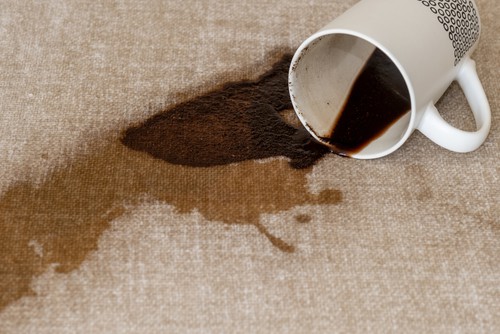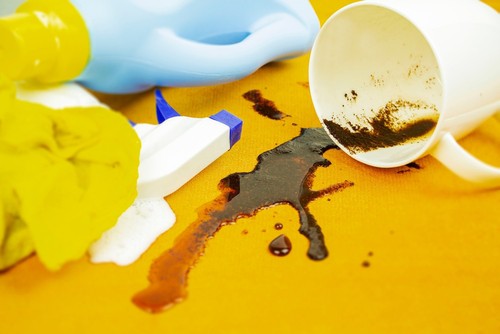Types of Leather Furniture and Their Cleaning Requirements

Upholstery vs Reupholstery – What to Choose?
August 30, 2023
Onsite Curtain Cleaning: Convenience Meets Quality
November 10, 2023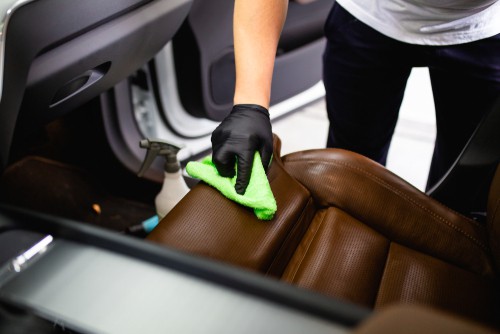
Types of Leather Furniture and Their Cleaning Requirements
Types of Leather Furniture and Their Cleaning Requirements. In this guide, we will delve into the diverse world of leather upholstery and explore the essential cleaning and maintenance practices that keep these pieces looking their best.
Leather furniture exudes timeless charm, but it’s vital to understand that not all leather is created equal, and each type requires specific care. Let’s embark on this journey of leather appreciation and care.
Read on – Types of Leather Furniture and Their Cleaning Requirements:
Table of Contents
ToggleThe Timeless Appeal of Leather Furniture
Before we dive into the specifics, let’s take a moment to appreciate the enduring allure of leather in furniture.
Leather has been a preferred choice for centuries due to its unique combination of qualities.
It offers exceptional durability, a comfortable seating experience, and a classic aesthetic that transcends trends.
Whether furnishing a contemporary loft or a traditional living room, leather furniture effortlessly complements various interior styles.
Types of Leather Used in Furniture
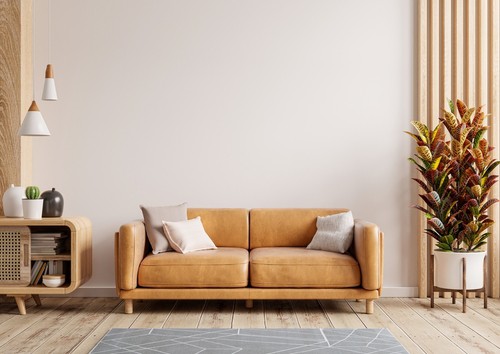
To understand how to care for leather furniture, it’s crucial to recognize the different types of leather commonly used in upholstery.
Each type has distinct characteristics that affect its look, feel, and maintenance requirements.
Let’s explore the primary categories of leather used in furniture.
Full-Grain Leather
Full-grain leather is the pinnacle of quality. It retains the natural grain and texture of the hide, showcasing the leather’s unique character.
This type of leather is exceptionally durable and ages gracefully, developing a beautiful patina over time.
Top-Grain Leather
Top-grain leather is another high-quality option, known for its smooth surface finish.
While it may not display as much natural texture as full-grain leather, it offers excellent durability and resistance to wear.
Split-Grain Leather
Split-grain leather is created from the lower layers of the hide and has a suede-like texture.
While it has a distinct look, it lacks the durability of full-grain and top-grain leather. Cleaning split-grain leather can be more challenging due to its delicate nature.
Bonded Leather
Bonded leather is an affordable option composed of leather scraps bonded with adhesives.
While it’s budget-friendly, it may not offer the same longevity as genuine leather. Cleaning and care must be approached with caution.
Faux Leather
Faux leather, also known as synthetic leather or leatherette, is entirely man-made.
It’s available in various colors and textures, offering versatility and affordability.
Cleaning faux leather is relatively straightforward, making it an attractive choice for those on a budget.
Full-Grain Leather
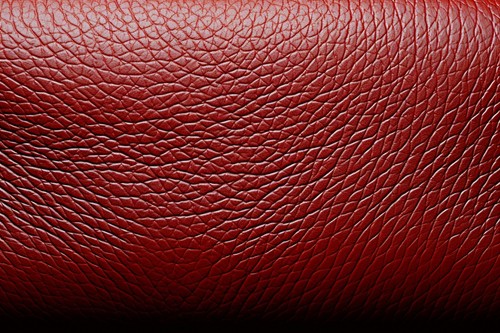
Now that we’ve introduced the main types of leather, let’s delve into each one in more detail, starting with full-grain leather.
Natural Grain and Texture
Full-grain leather proudly displays the natural grain and texture of the hide.
This unique feature adds character and charm to each piece of furniture. No two full-grain leather pieces are exactly alike, making them truly special.
Durability and Aging Gracefully
Full-grain leather is celebrated for its durability. It can withstand the test of time and daily use, often improving in appearance over the years. With proper care, full-grain leather furniture can last for generations.
Cleaning and Care Requirements
Cleaning full-grain leather is relatively straightforward:
- Dust and Vacuum: Regularly vacuum your full-grain leather furniture to remove surface dirt and debris.
- Gentle Cleaning: Use a damp, soft cloth or sponge with a mild leather cleaner for deeper cleaning. Avoid harsh chemicals that can damage the leather.
- Conditioning: Apply a leather conditioner specifically formulated for full-grain leather. This helps maintain its suppleness and prevents it from drying out.
Remember that full-grain leather thrives on natural oils and moisture, so keep it away from direct sunlight and heat sources.
Top-Grain Leather
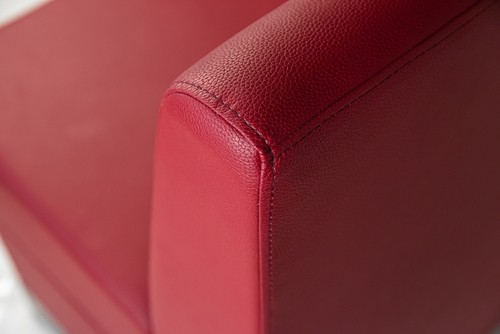
Smooth Surface Finish
Top-grain leather boasts a smooth and polished surface finish. While it may not showcase as much natural texture as full-grain leather, its sleek appearance is highly appealing.
Quality and Durability
Top-grain leather is recognized for its quality and durability. It can withstand regular use and is less susceptible to damage than other leather types.
Maintenance and Cleaning Tips
Here are some maintenance and cleaning tips for top-grain leather:
- Regular Dusting: Like full-grain leather, regularly dust and vacuum your top-grain leather furniture to remove surface dirt.
- Mild Cleaning: Use a mild leather cleaner and a soft cloth or sponge for deeper cleaning. Avoid abrasive materials or harsh chemicals.
- Conditioning: Apply a leather conditioner specifically designed for top-grain leather to keep it supple and maintain its sheen.
Like full-grain leather, top-grain leather benefits from a consistent moisture level and should be protected from direct sunlight and excessive heat.
Split-Grain Leather
Suede-Like Texture
Split-grain leather has a suede-like texture, which sets it apart from other types of leather.
Its unique appearance can be a selling point but comes with specific cleaning challenges.
Limited Durability
One drawback of split-grain leather is its reduced durability compared to full-grain and top-grain leather.
It’s more susceptible to wear and damage, making proper care crucial.
Cleaning Challenges and Solutions
Cleaning split-grain leather requires a delicate touch:
- Dry Cleaning: Clean with a soft brush or suede brush to remove loose dirt and restore the suede texture.
- Spot Cleaning: Use a suede eraser or a mixture of white vinegar and water for stains. Test in an inconspicuous area first to ensure it doesn’t damage the leather.
- Avoid Water: Unlike other leather types, split-grain leather doesn’t tolerate water well. Minimize exposure to moisture and humidity.
Proper storage and protection from moisture are essential for maintaining the appearance of split-grain leather furniture.
Bonded Leather
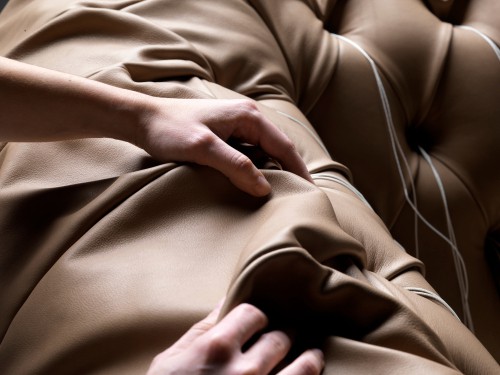
Composition and Quality
Bonded leather comprises leather scraps bonded with adhesives and then coated with a polyurethane layer.
While it offers affordability, its quality and longevity may not match genuine leather.
Care and Maintenance Guidelines
Cleaning and maintaining bonded leather require special attention:
- Gentle Cleaning: Use a mild soap and water solution or a leather cleaner formulated for bonded leather. Wipe gently with a soft cloth.
- Avoid Harsh Chemicals: Harsh chemicals can damage the polyurethane coating, so steer clear.
- Conditioning: Bonded leather doesn’t require conditioning, as it lacks the natural pores found in genuine leather.
Due to its composition, bonded leather may be more prone to peeling and wear, especially if subjected to heavy use.
Faux Leather
Affordability and Variety
Faux leather is a budget-friendly alternative to genuine leather. It’s available in various colors and textures, providing flexibility in design and affordability.
Cleaning and Caring for Synthetic Leather
Cleaning faux leather is relatively easy:
- Dusting: Start by regularly dusting your faux leather furniture to prevent dirt buildup.
- Mild Cleaning: For deeper cleaning, use mild soap and water. Wipe gently with a soft cloth or sponge.
- Avoid Harsh Chemicals: As with bonded leather, harsh chemicals can damage the synthetic surface, so stick to gentle cleaning agents.
Faux leather is less demanding in maintenance, making it an attractive choice for those seeking both affordability and ease of care.
Cleaning Leather Furniture Safely
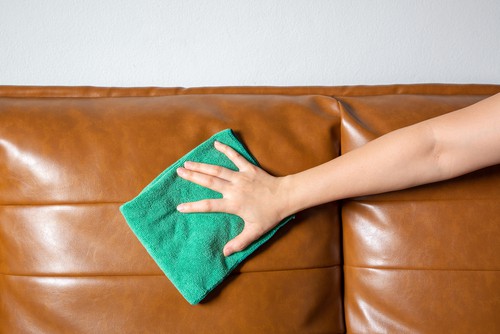
Now that we’ve covered the specifics of each leather type let’s discuss some general principles for safely cleaning leather furniture.
Regular Dusting and Vacuuming
Regardless of the leather type, regular dusting and vacuuming are essential.
Dust and debris can settle on the surface and, over time, cause scratches and damage. Use a soft brush attachment on your vacuum cleaner to gently remove surface dirt.
Spot Cleaning for Stains
Tackle stains promptly using the appropriate cleaner for your leather type. Always test any cleaning product in an inconspicuous area first to ensure it doesn’t harm the leather.
Leather Conditioner Application
Leather, especially full-grain and top-grain varieties, benefits from occasional conditioning. Leather conditioner helps maintain its suppleness and prevents it from drying out and cracking. Follow the manufacturer’s instructions for the specific conditioner you choose.
Specific Care for Each Leather Type
Let’s now delve into the specifics of caring for each type of leather—full-grain, top-grain, split-grain, bonded, and faux leather.
Full-Grain Leather
- Dust and Vacuum: Regular dusting and vacuuming.
- Mild Cleaning: Use a damp, soft cloth or sponge with a mild leather cleaner.
- Conditioning: Apply a leather conditioner specifically formulated for full-grain leather.
Top-Grain Leather
- Regular Dusting: Dust and vacuum your top-grain leather furniture regularly.
- Mild Cleaning: Use a mild leather cleaner and a soft cloth or sponge.
- Conditioning: Apply a leather conditioner designed for top-grain leather.
Split-Grain Leather
- Dry Cleaning: Begin with dry cleaning using a soft or suede brush.
- Spot Cleaning: Use a suede eraser or a mixture of white vinegar and water for stains.
- Avoid Water: Minimize exposure to moisture and humidity.
Bonded Leather
- Gentle Cleaning: Use a mild soap and water solution or a leather cleaner for bonded leather.
- Avoid Harsh Chemicals: Harsh chemicals can damage the polyurethane coating.
Faux Leather
- Dusting: Regularly dust your faux leather furniture to prevent dirt buildup.
- Mild Cleaning: Use a mixture of mild soap and water for deeper cleaning.
Preventing Common Issues

Preserving the beauty and integrity of your leather furniture involves more than just cleaning. Here are some proactive steps to prevent common issues:
- Protection from Sunlight: Direct sunlight can cause the leather to fade and dry out. Position your leather furniture away from direct sunlight or use curtains and blinds to shield it.
- Proper Ventilation: Leather furniture can benefit from proper ventilation. Avoid placing it against walls, which can trap moisture and cause mildew.
- Maintain Humidity: Leather thrives in a controlled environment with moderate humidity. Use a humidifier or dehumidifier to maintain the ideal moisture level.
Professional Cleaning and Restoration
While regular cleaning and maintenance can significantly extend the life of your leather furniture, there may come a time when professional help is needed.
Professional cleaning and restoration services can address deep-seated dirt, stains, or damage that home cleaning methods can’t handle.
Consider seeking professional assistance when your leather furniture requires a thorough rejuvenation.
Budget Considerations
The cost of cleaning and maintaining leather furniture varies depending on the type of leather and the products you choose.
Investing in quality cleaning and conditioning products is worthwhile to ensure the longevity of your furniture.
Remember that proper care can prevent costly repairs or replacements in the long run.
Frequently Asked Questions (FAQs)
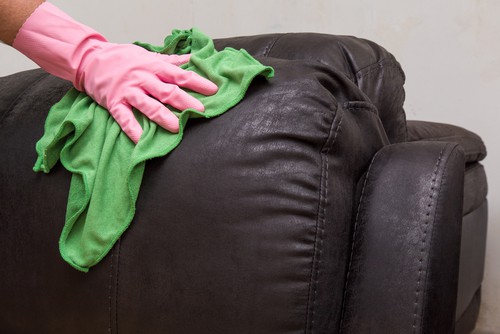
1. How often should I clean my leather furniture?
The frequency of cleaning depends on factors like usage and environmental conditions. Dusting and light cleaning should be done regularly, while deeper cleaning and conditioning can be performed every few months.
2. Can I use household products for cleaning leather?
It’s best to use products specifically formulated for leather cleaning. Household products may contain chemicals that can harm leather. Always test any new product in an inconspicuous area first.
3. What’s the best way to prevent leather furniture from drying out?
Prevent leather from drying out by avoiding direct sunlight and heat sources. A leather conditioner designed for your specific type can also help maintain moisture.
Types of Leather Furniture and Their Cleaning Requirements – Conclusion
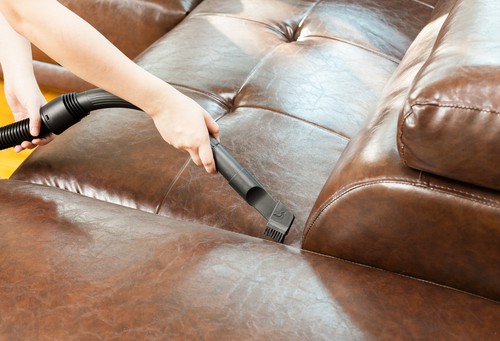
In conclusion, leather furniture adds a touch of luxury and timelessness to any space.
Proper care and maintenance are essential to ensure your leather furniture remains as stunning and comfortable as the day you brought it home.
Remember that different types of leather have distinct requirements, so constantly tailor your cleaning and care practices accordingly.
Following the guidelines outlined in this comprehensive guide, you can enjoy your leather furniture for years.
Are you seeking professional and reliable upholstery cleaning services in Singapore? Contact us today!

